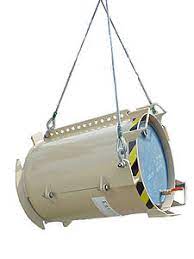Are you using the right types of containers for your business? Many shipping containers are available to transport bulk cargo. But each container has a different purpose. So, choosing the appropriate shipping container types will give you a smoother shipping experience.
As a shipping expert for over ten years, we have helped companies with international deliveries. Thus, you can choose the most suitable container types for shipping cargo. As a result, it enables you to ensure safe delivery and keep your cargo protected.
This article will discover the shipping containers types for bulk transport. So let’s jump right in.

- Types of Shipping Container
- 1. Flat rack container
- 2. Dry storage container
- 3. Tunnel container
- 4. Open top containers
- 5. Open-side storage container
- 6. ISO Tank Container
- 7. Half height containers
- 8. High cube container
- 9. Insulated or Thermal containers
- 10. Drums
- 11. Double doors container
- 12. Refrigerated ISO container
- 13. Swap bodies
- 14. Car carriers
- 15. Special purpose container
- FAQs about Types of Containers
- What’s Next
Types of Shipping Container
1. Flat rack container

The flat rack container resembles a typical storage shipping container in shape. The benefit of flat rack containers is that they have foldable sides. Thus, you can fold them to create a flat rack for shipping various items.
Flat rack containers are suitable for carrying large items. These items include heavy machinery, cars on tracks, large reels, and building materials. Besides, its end walls are strong enough to withstand goods.
2. Dry storage container

The most popular type of shipping container is a dry storage container. It is also called general-purpose containers. Their ISO-standardized sizes are 20, 40, and 10 feet.
Dry storage containers can be completely enclosed, waterproof, and protected from the elements. It is because of their hard top, sides, and floor.
Besides, some of them have changes to the features. The purpose is to carry certain kinds of dry or liquid bulk cargo. Examples of these items are liner bags or flexitanks.
I have noticed many SHIPPING SERVICES using this type of container. The reason; it is an ISO-standardized container.
A Fast , Easy and Cheap Way to Ship from China
Do not hesitate to contact Leeline Sourcing at any time regarding your shipments from China.
3. Tunnel container

Customers choose tunnel containers for easy loading. It is because a tunnel container has doors on both ends. These made the tunnel container particularly practical for quick item loading and unloading.
They are crucial for shipping steel or other heavy metals due to the open doors’ extra space. The container also has robust locking mechanisms and weather-tight sealing on both sides. It is to protect objects while transporting them.
4. Open top containers

Open-top containers have a convertible top that you can remove entirely to make an open-top container. Thus, this open-top container can ship materials of any height quickly.
What I like the MOST about the OPEN TOP container is its features for removing and putting the top cover. It is A FLEXIBLE feature.
They are ideal for large, bulky items like tall machinery. These goods cannot be loaded through the container entrance.
Besides, these containers have 40′ and 20′ lashing rings. These rings are fastened to the top and lower side rails and the corner posts to hold the cargo in place.
5. Open-side storage container

You may change the doors of open-side storage containers. It can become completely open sides, resulting in a much wider loading area.
What is the main difference between open-side containers and regular? The answer is that you can open the entire doors of the former.
The wider space and access of this storage unit allow simple loading and unloading of items. 20′ and 40′ open-side shipping containers are the standard sizes. They provide room for large items that won’t fit through ordinary doors.
6. ISO Tank Container

ISO Tanks are being designed with ISO standards. Carriers usually use it to transport liquid materials (International Organization for Standardization). Manufacturers use strong steel or other anti-corrosive materials to construct tankers.
It allows carriers to transport both hazardous and non-hazardous liquid materials in bulk. But tank containers must be at least 80% full. The purpose is to prevent dangerous liquid materials from leaping during transport. But, they must not be more than 95% full to allow temperature rise.
7. Half height containers

The height of half-height containers is half the height of full-sized containers. It is suitable for goods like coal and stones that need simple loading and unloading. These container storage units can also transport heavy, thick, and bulk materials.
Besides, half-height containers have a lower center of gravity than taller containers. It allows a half-height container to handle heavier loads. They are also more adaptable to the harsh industrial environment.
My experience!
The half-height container is always a GREAT selection for SEA SHIPPING. It has a HIGHER SPACE ratio.
Looking to find a reliable Chinese supplier?
As the best China sourcing agent, we help you find factories, get competitive prices, follow up production, ensure quality and deliver products to the door.
8. High cube container

Do you need to SHIP a bigger VOLUME? My choice is a HIGH-cube container. It offers QUITE high space and safety.
High cube containers are similar in structure to general-purpose containers. But, they are taller by about 1 foot. It comes in sizes 40′ and sometimes 45′.
This container can transport all forms of everyday goods. It is common in cases where you need a bigger volume capacity container like this.
Most high cube containers feature a hole in the floor at the front end. It is to center the container on the so-called gooseneck chassis. It enables it to lie lower and be of a higher design.
9. Insulated or Thermal containers

The thermal and insulated containers have adjustable temperature controls. It enables them to maintain temperature controlled environment. The container’s inside is made of solid construction materials. I have stored many different materials. Inside, anti-corrosive materials can withstand a higher temperature without suffering harm.
This shipping container uses mechanical engines that are powered by electricity. It is to cool or warm the air within the thermal container. Like a “thermos” bottle, insulated containers are often made of vacuum flasks.
Insulated or thermal containers have several advantages over other containers. Hence, they are suitable for transporting goods for long-distance transportation.
10. Drums

Drums are round storage containers. Manufacturers made it from materials like steel, fiber, rigid plastic, and light metal
There are many kinds of these container storage units. Each is fashioned of different materials and designed for a particular use.
Drums are a typical packing option for exporting vast amounts of goods. These goods include food, material, or oil. It is especially true for international travel because of its incredibly durable design. But, their design is more space-consuming aboard a vessel and smaller.
11. Double doors container

A storage container type with double doors is a double doors container.
It has the benefit of creating a larger space for material loading and unloading. Steel, iron, and other building materials in 20- and 40-foot lengths are used to construct it.
Weather-resistant seals and identical locking systems are included too. It is included on both sets of doors in double-door containers. These designs keep cargo safe from the elements. In addition, the container meets ISO standards. Therefore, you may use it for international freight (CSC).
12. Refrigerated ISO container

Refrigerated ISO containers are also known as Temperature-controlled shipping containers. This container type is frequently made of “Cor-ten” steel, weathering steel. Besides, it typically comes in 20′ and 40′ lengths and is also known as a reefer container.
When compared to other containers, refrigerated ISO containers have an advantage. It is because they are maintained at a controlled, low temperature.
It is GOOD if you have products that need LOW TEMPERATURE for storage. I have stored many food products.
This shipping container type is mainly used to carry perishable commodities. For example, foods that spoil quickly, like fruits, meat, and vegetables. It is also helpful to transport medicinal products that require a specific temperature.
13. Swap bodies

Swap bodies are a unique container type that is mainly utilized in Europe. They are not built following ISO standards. They are also not standardized shipping container units. Still, they are nonetheless very helpful.
I have used them for many PURPOSES. They are GREAT, and swapping features increase flexibility.
Exchangeable containers called swap bodies are used on the road and rail. It is because they have a sturdy bottom and a detachable top. So, they are perfect for delivering various items. But you can only use swap bodies for land-based transportation. It is because they lack top-corner fittings, and you cannot stack them on a container ship.
14. Car carriers

Car carriers are 40-foot containers that are over height. It also has an automated or manual lift system.
They transport cars or other vehicles across long distances. It can transport four automobiles. Besides, it functions as a typical dry van when you fold the lift mechanism onto the top. It is helpful for the transportation of a variety of cargoes.
Car carriers have the advantage of having folding sides. It allows a vehicle to fit within. As a result, you need not worry about moving or damages during transit.
15. Special purpose container

Special purpose containers are not regular containers. They are container units built especially for their uses. They are mainly employed for high-profile tasks like shipping weaponry and setting fires.
The unique purpose they must serve determines how they are built and what materials they are made of.
Military personnel may operate in a secure and long-lasting environment. It is made possible by specific purpose containers for things. For example, command and control, command and habitation, weaponry, and storage and energy.
FAQs about Types of Containers
1. In what circumstances can you not use containers?
You shouldn’t use any types of shipping containers if a high level of security is essential. It is because containers are still a very new technology. They’re not yet considered as safe as virtual machines (VMs).
2. Why are there different container types?
Various types of shipping containers meet different cargo shipping needs. These container units may differ in size, structure, materials, and construction. It depends on the goods to deliver or the unique services the customer needs.
3. What are the four types of ocean containers?
The four ocean container types include Dry Van shipping containers. Secondly, Reefer tank shipping containers. Thirdly, FCL shipping containers, and finally LCL shipping containers. The size, structure, materials, and methods of building each vary.
What’s Next
To conclude, the most popular container type is dry storage containers. Meanwhile, flat rack container types enable easy loading of large items or heavy loads. You can load items like machinery or cars on track easier. Special-purpose container types are for delivering weapons and destroying ships.
Need professional advice on international shipment? Leeline Sourcing has been in the freight forwarding industry for over ten years. Contact us today to get your ultimate shipping solution!








